A story on the Internet explains how a man had to spend US$14,000 (approximately Sh1 million) fixing his Porsche Cayenne after his wife accidentally filled it up with diesel at the fuel dispenser instead of petrol.
The story got me thinking: what is the big deal about whether a car runs on petrol or diesel? Does the car still not require periodic filling up? Aren’t they all started with a key (at least for motor vehicles)?
Don’t the controls work the same for both types of cars? What is the difference anyway?
Well, here we go:
1. Injection: In the days of old, petrol was mixed with air — roughly in the ratio 1:15 respectively — by a device called a carburettor. Subsequent technology introduced fuel injection, but the main basis of fuel delivery for a petrol engine was that it was mixed with air outside the cylinders before the mixture was set on fire within the cylinder by means of a spark plug.
Diesel engines had the fuel injected into a mass of hot compressed air for them to run efficiently, and this difference brings us to the next difference, ignition.
2. Ignition: The physical qualities of petrol and diesel are vastly different. Petrol is a lighter, more volatile liquid (and thus more flammable) than diesel, which is heavier, oily and stinks to high heaven.
As such, their combustion properties are different. Petrol requires a naked flame, and not necessarily a very hot one, before going boom. But liquid petrol does not burn.
Yes, you read right, liquid petrol does not burn; petrol vapour does. The volatility of petrol means it is very easily vaporised, which explains how early examples of petrol engines used simple carburettors.
Diesel, being heavier and more viscous, is even more reluctant to combust in liquid form. To compound matters, it does not vaporise easily, nor will it catch fire no matter how naked the flame introduced is.
When injected into the engine, it has to go through extremely high pressure injectors which then feed a very tiny nozzle to completely atomise the fuel.
Pure air is sucked into the diesel engine and compressed to a very small volume. Remember Charles and Boyle from Form One Chemistry? The compressed air, now at high pressure, becomes extremely hot (roughly 550°C), and it is to this hot, squashed gas that the diesel oil is injected. It then has little choice but to burn, releasing large amounts of energy in the process.
3. Compression Ratio: Sounds fancy and complicated, but compression ratio is the relationship between the air coming into the engine before it is compressed and after it is compressed.
A higher compression ratio means a higher degree of squeezing; therefore a low compression ratio means little squeezing. Diesel engines typically have higher compression ratios than petrol engines so that the compressed air can reach a temperature high enough to ignite the diesel.
Petrol engines have lower compression ratios to prevent pre-ignition, a case where the air-fuel mixture catches fire in the cylinder before it is supposed to.
The difference in compression ratios also explains why drivers talk of “heavy” gears in a diesel: it is difficult to get a smooth downshift in a diesel without double declutching or waiting for the engine revs to decay completely before shifting because of the closed-throttle compression resistance offered by the engine.
4. Power and Torque: It is difficult to explain the difference between power and torque without revisiting high school physics, but it can be put down to this: torque is the amount of “twist” in the driveshaft provided by the engine, while power is the rate of that twist.
Does that make sense? Another way of looking at it is this way: torque is what gets you going, while power is what keeps you going. Torque determines acceleration or load-pulling ability (depending on the gearbox), while power determines absolute speed.
Better now? Petrol engines tend to have a lot of power, but little torque, mostly depending on engine capacity and design. That explains why smaller versatile vehicles tend towards petrol power.
Diesels have it the other way round: they usually have excellent torque characteristics, but low power, especially in the upper reaches of the rev range where maximum power is reached.
This is why heavy commercial vehicles and tractors come fitted with oil-burning mills. So, if you want to set a land speed record, concentrate your efforts around a petrol engine; if you want to move a chunk of that land — slowly — think diesel.
5. NVH (Noise, Vibration and Harshness): The smoothest internal combustion engines are almost always petrol powered.
Old car magazines that I go through describe diesel engine smoothness (or lack thereof) in amusing ways, using analogies like “…kicking a rusty can down a cobbled street”, “…an old oil drum rolling down the face of a quarry” and “…loose gravel inside a food blender”.
Diesels operate at much lower engine rpm (making frequency lower and harder to damp or “rectify”, to use an electrical term), and that they are made from much heavier components than their petrol counterparts.
Giving them high moments of inertia
All these describe the aural signatures from diesel engines of eras past, though advancement in noise suppression has made life bearable for owners of newer diesel engines.
On a bad day, the simple idling from a diesel engine is enough to shake and rattle an entire vehicle. The low idling speed of the engine also gives the engine a characteristic “knock”, not the mechanical defect, but the noise, unlike the smooth thrum of a high-speed idle petrol.




